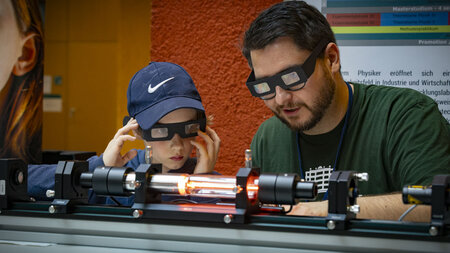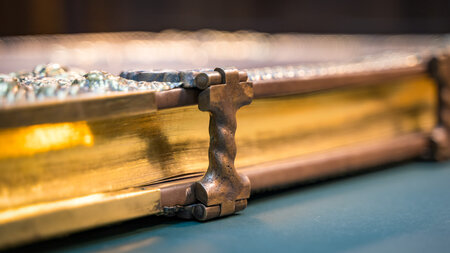Eintrag in der Universitätsbibliographie der TU Chemnitz
Volltext zugänglich unter
URN: urn:nbn:de:bsz:ch1-qucosa-71217
Thurmer, Dominic J.
Albrecht, Manfred (Prof. Dr.) (Gutachter)
Nanomembrane-based hybrid semiconductor-superconductor heterostructures
Kurzfassung in englisch
The combination of modern self-assembly techniques with well-established top-down processing methods pioneered in the electronics industry is paving the way for increasingly sophisticated devices in the future[1]. Nanomembranes, made from a variety of materials, can provide the necessary framework for a diverse range of device structures incorporating wrinkling, buckling, folding, and rolling of thin films[2, 3]. Over the past decade, an elegant symbiosis of bottom-up and top-down methods has been developed, allowing the fabrica- tion of hybrid layer systems via the controlled release and rearrangement of inherently strained layers [4]. Self-assembled rolled-up structures[4, 5] have become increasingly at- tractive in a number of fields including micro/nano uidics[6], optics[7](including metama- terial optical fibers[8]), Lab on a Chip applications[9], and micro- and nanoelectronics[10]. The use of such structures for microelectronic applications has been driven by the versatility in contacting geometries and the abundance of material combinations that these devices offer. By allowing devices to expand in the third dimension, certain obstacles that inhibit 2D structuring can be overcome in elegant ways. Similarly, recent progress in nanostructured superconducting electronic structures has been receiving increased attention[11]. The advancement of such devices has been mo- tivated by their use in quantum computation[12], high sensitivity radiation sensors[13], precision voltage standards[14] and superconducting spintronics[15] to name a few. Combining semiconductor with superconductor materials to create new hybrid geometries is advantageous because it adds the functionalities of the semiconductor, including high charge carrier mobilities, gating possibilities, and refined processing technologies.The main focus of the work presented in this thesis is the development of new methods for controlling strain behavior and its applications toward novel semiconduc- tor/superconductor heterostructures based on nanomembranes. More specifically, the goal is to integrate inherently strained semiconductor layer structures with superconducting materials to create innovative electronic devices by the controlled releasing and rearrangement of thin films. By rolling up pre-patterned semiconductor/superconductor layers, device geometries have been realized that are not feasible using any other technique. In this way, superconducting hybrid junctions, or Josephson junctions, have been created and their basic properties investigated.
The Josephson effect, and junctions displaying this quantum coherent behavior, have found many essential uses in diverse areas of science and technology. Many research groups around the world are involved in finding new materials and fabrication methods to tune the properties and structure of such Josephson devices further[11]. The inclusion of semi- conductors, for example, allows for a greater control of the charge carrier density within the junction area, thus allowing for "transistor-like" behavior in these superconducting devices.
By rolling up the superconductor contacts using a strained semiconductor as scaffolding, the fabrication of hybrid nano-junctions is simplified drastically, removing the need for complicated processing steps such as electron-beam or nano-imprint lithography. Furthermore, the technique allows many nanometer-sized devices to be created in parallel on a single chip which has the advantage that it can be scaled up to full-wafer processing.
First, post-growth processing techniques of epitaxial layers are developed in order to extend the control of hybrid device fabrication. Here, three unique concepts for controlling the rolling behavior of strained semiconductor nanomembranes are presented. First an optical method for inhibiting the rolling of the strained layers is described. Next, a selective etching method for destroying the inherent strain within the semiconductor layer is introduced. Finally, a method by which the strain gradient across a trilayer stack is altered in situ during rolling is presented. Next, the fabrication of a hybrid nanomembrane-based superconducting device is presented. Various experimental details of the fabrication process are analyzed, and the electronic properties of the completed device are investigated. The devices created here highlight the fabrication process in which nanometer-sized structures are created using self-assembly techniques and standard microelectronics fabrication methods, presenting a new method to circumvent more complicated processing techniques.
References
[1] G. M. Whitesides and B. Grzybowski. Self-assembly at all scales. Science 295, 2418{2421 (2002).
[2] Y. G. Sun, W. M. Choi, H. Q. Jiang, Y. G. Y. Huang and J. A. Rogers. Controlled buckling of semiconductor
nanoribbons for stretchable electronics. Nature Nanotechnology 1, 201{207 (2006).
[3] O. G. Schmidt and K. Eberl. Nanotechnology - Thin solid films roll up into nanotubes. Nature 410, 168 (2001).
[4] O. G. Schmidt, C. Deneke, Y. Nakamura, R. Zapf-Gottwick, C. Mller and N. Y. Jin-Phillipp. Nanotechnology
{ Bottom-up meets top-down. Advanced Solid State Physics 42, 231 (2002).
[5] V. Ya. Prinz, V. A. Seleznev, A. K. Gutakovsky, A. V. Chehovskiy, V. V. Preobrazhenskii, M. A. Putyato
and T. A. Gavrilova. Free-standing and overgrown InGaAs/GaAs nanotubes, nanohelices and their arrays. Physica
E 6, 828 (2000).
[6] D. J. Thurmer, C. Deneke, Y. F. Mei and O. G. Schmidt. Process integration of microtubes for
uidic applications.
Applied Physics Letters 89, 223507 (2006).
[7] R. Songmuang, A. Rastelli, S. Mendach and O. G. Schmidt. SiOx/Si radial superlattices and microtube optical
ring resonators. Applied Physics Letters 90, 091905 (2007).
[8] E. J. Smith, Z. W. Liu, Y. F. Mei and O. G. Schmidt. Combined surface plasmon and classical waveguiding through
metamaterial fiber design. Nano Letters 10, 1{5 (2010).
[9] G. S. Huang, Y. F. Mei, D. J. Thurmer, E. Coric and O. G. Schmidt. Rolled-up transparent microtubes as
two-dimensionally confined culture scaffolds of individual yeast cells. Lab on a Chip 9, 263{268 (2009).
[10] C. C. B. Bufon, J. D. C. Gonzalez, D. J. Thurmer, D. Grimm, M. Bauer and O. G. Schmidt. Self-assembled
ultra-compact energy storage elements based on hybrid nanomembranes. Nano Letters 10, 2506{2510 (2010).
[11] G. Katsaros, P. Spathis, M. Stoffel, F. Fournel, M. Mongillo, V. Bouchiat, F. Lefloch, A. Rastelli,
O. G. Schmidt and S. De Franceschi. Hybrid superconductor-semiconductor devices made from self-assembled
SiGe nanocrystals on silicon. Nature Nanotechnology 5, 458{464 (2010).
[12] Y. J. Doh, J. A. van Dam, A. L. Roest, E. P. A. M. Bakkers, L. P. Kouwenhoven and S. De Franceschi.
Tunable supercurrent through semiconductor nanowires. Science 309, 272{275 (2005).
[13] F. Giazotto, T. T. Heikkila, G. P. Pepe, P. Helisto, A. Luukanen and J. P. Pekola. Ultrasensitive proximity
Josephson sensor with kinetic inductance readout. Applied Physics Letters 92, 162507 (2008).
[14] S. P. Benz. Superconductor-normal-superconductor junctions for programmable voltage standards. Applied Physics
Letters 67, 2714{2716 (1995).
[15] Y. C. Tao and J. G. Hu. Superconducting spintronics: Spin-polarized transport in superconducting junctions with
ferromagnetic semiconducting contact. Journal of Applied Physics 107, 041101 (2010).
| Universität: | Technische Universität Chemnitz | |
| Institut: | Institut für Physik Allgemein | |
| Fakultät: | Fakultät für Naturwissenschaften | |
| Dokumentart: | Dissertation | |
| Betreuer: | Schmidt, Oliver G. (Prof. Dr) | |
| URL/URN: | http://nbn-resolving.de/urn:nbn:de:bsz:ch1-qucosa-71217 | |
| SWD-Schlagwörter: | Technische Membran , Kompositmembran , Supraleitung | |
| Freie Schlagwörter (Deutsch): | Nanomembranen , Aufgerollte Mikroröhrchen | |
| Freie Schlagwörter (Englisch): | Self-assembly , nanomembranes , Josephson junction , superconductivity | |
| DDC-Sachgruppe: | Physik, Klassische Mechanik; Festkörpermechanik, Moderne Physik, Elektrizität, Elektronik | |
| Tag der mündlichen Prüfung | 20.07.2011 |




